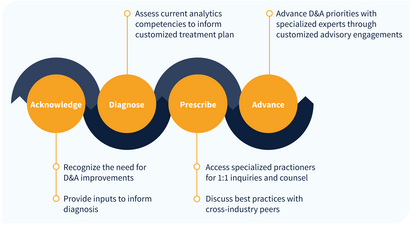Client Inquiry:
We're just starting down the path of using a center of excellence (CoE) approach for analytics with a centralized group and dotted lines to the embedded analysts in the business units. Do you have any high-level insights you can share with us?
Expert Takeaways:
Managing Demand
- One of the key functions of the centralized team is to manage demand.
- In general, the embedded teams will provide use cases that describe the business needs so that data scientists in the CoE will understand the problems the business wants to solve as they built their models.
- The embedded teams can also perform base descriptive and diagnostic tasks, and help the business analysts with the creation and interpretation of ad-hoc analytics questions.
- When allocating data science resources back to the business, look at the products and services you are delivering to that particular business unit. This might be a best guess based on what you forecast will be needed.
- As the CoE receives more requests, it can reallocate resources as needed.
- Track how each project is implemented, and what the financial impact of using the models is for the business. This will help you better understand where to allocate resources.
Federated Analytics
- Keep the future in mind. Many companies are aiming for federated models with completely embedded analytics. To do this, you need to have an established analytics culture in place and the right set of tools and controls.
- The delivery framework will be self-service with the CoE simply managing what the end users can access.
- The first big step toward that goal is building a data lake with partitions around different data sets. This allows you to point end users to one place for particular data. The CoE provides the access tools.
- Ultimately, the self-service model has to center around two things: ability to look at data in different ways than it's organized in the core and access to tools that allow for ad-hoc analyses.
Analysts as the Bottleneck
- Sometimes the embedded analysts are the bottleneck in the process. For example, product teams how have become overly reliant on the analyst to provide information even when they have dashboards and good tools. This can slow down progress on bigger projects.
- In addition, citizen developers can put up barriers even though both sides want to help the business. Work with these developers so they know you're not the enemy.
- To help break down resistance in the business units, find your true evangelists within the teams and shower them with support. The goal is to get them excited about their successes so that they'll show their teams what can be achieved.
Expert Network
IIA provides guided access to our network of over 150 analytics thought leaders, practitioners, executives, data scientists, data engineers with curated, facilitated 1-on-1 interactions.
- Tailored support to address YOUR specific initiatives, projects and problems
- High-touch onboarding to curate 1-on-1 access to most relevant experts
- On-demand inquiry support
- Plan validation and ongoing guidance to advance analytics priority outcomes
- Monthly roundtables facilitated by IIA experts on the latest analytics trends and developments
